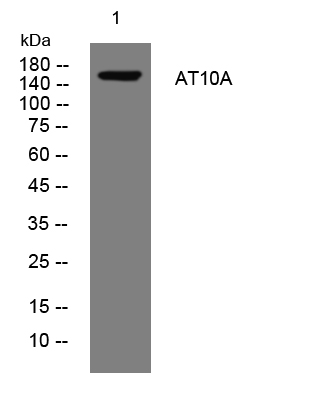AT10A Rabbit Polyclonal Antibody
AT10A Rabbit Polyclonal Antibody
- 产品详情
- 实验流程
- 背景知识
Application
| WB |
|---|---|
| Primary Accession | O60312 |
| Reactivity | Human, Mouse |
| Host | Polyclonal, Rabbit,IgG |
| Clonality | Polyclonal |
| Calculated MW | 167688 Da |
| Gene ID | 57194 |
|---|---|
| Other Names | Phospholipid-transporting ATPase VA, 7.6.2.1, ATPase class V type 10A, Aminophospholipid translocase VA, P4-ATPase flippase complex alpha subunit ATP10A, ATP10A {ECO:0000303|PubMed:25947375} |
| Dilution | WB~~1:1000 |
| Storage Conditions | -20℃ |
| Name | ATP10A {ECO:0000303|PubMed:25947375} |
|---|---|
| Function | Catalytic component of P4-ATPase flippase complex, which catalyzes the hydrolysis of ATP coupled to the transport of phosphatidylcholine (PC) from the outer to the inner leaflet of the plasma membrane (PubMed:25947375, PubMed:29599178, PubMed:30530492). Initiates inward plasma membrane bending and recruitment of Bin/amphiphysin/Rvs (BAR) domain-containing proteins involved in membrane tubulation and cell trafficking (PubMed:29599178). Facilitates ITGB1/beta1 integrin endocytosis, delaying cell adhesion and cell spreading on extracellular matrix (PubMed:25947375, PubMed:29599178). Has low flippase activity toward glucosylceramide (GlcCer) (PubMed:30530492). |
| Cellular Location | Cell membrane; Multi-pass membrane protein. Endoplasmic reticulum membrane Note=Exit from the endoplasmic reticulum requires the presence of TMEM30A, but not that of TMEM30B |
| Tissue Location | Widely expressed, with highest levels in kidney, followed by lung, brain, prostate, testis, ovary and small intestine |
For Research Use Only. Not For Use In Diagnostic Procedures.
Provided below are standard protocols that you may find useful for product applications.
BACKGROUND
The protein encoded by this gene belongs to the family of P-type cation transport ATPases, and to the subfamily of aminophospholipid-transporting ATPases. The aminophospholipid translocases transport phosphatidylserine and phosphatidylethanolamine from one side of a bilayer to another. This gene is maternally expressed. It maps within the most common interval of deletion responsible for Angelman syndrome, also known as 'happy puppet syndrome'. [provided by RefSeq, Jul 2008],
终于等到您。ABCEPTA(百远生物)抗体产品。
点击下方“我要评价 ”按钮提交您的反馈信息,您的反馈和评价是我们最宝贵的财富之一,
我们将在1-3个工作日内处理您的反馈信息。
如有疑问,联系:0512-88856768 tech-china@abcepta.com.























 癌症的基本特征包括细胞增殖、血管生成、迁移、凋亡逃避机制和细胞永生等。找到癌症发生过程中这些通路的关键标记物和对应的抗体用于检测至关重要。
癌症的基本特征包括细胞增殖、血管生成、迁移、凋亡逃避机制和细胞永生等。找到癌症发生过程中这些通路的关键标记物和对应的抗体用于检测至关重要。 为您推荐一个泛素化位点预测神器——泛素化分析工具,可以为您的蛋白的泛素化位点作出预测和评分。
为您推荐一个泛素化位点预测神器——泛素化分析工具,可以为您的蛋白的泛素化位点作出预测和评分。 细胞自噬受体图形绘图工具为你的蛋白的细胞受体结合位点作出预测和评分,识别结合到自噬通路中的蛋白是非常重要的,便于让我们理解自噬在正常生理、病理过程中的作用,如发育、细胞分化、神经退化性疾病、压力条件下、感染和癌症。
细胞自噬受体图形绘图工具为你的蛋白的细胞受体结合位点作出预测和评分,识别结合到自噬通路中的蛋白是非常重要的,便于让我们理解自噬在正常生理、病理过程中的作用,如发育、细胞分化、神经退化性疾病、压力条件下、感染和癌症。






